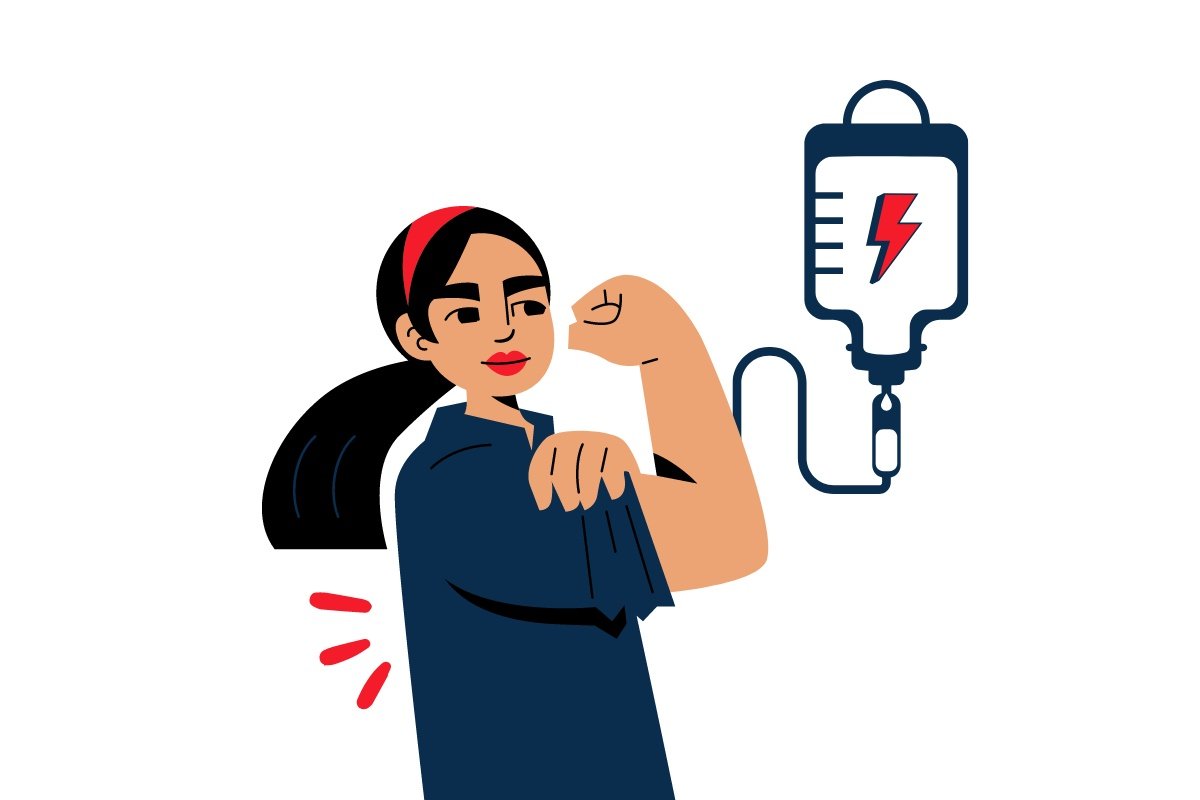Are you tired all the time? Have you put on weight recently? Did you know that there is such a thing as an iron deficiency headache? Tiredness, seemingly unexplainable weight gain and headaches can all be symptoms of iron deficiency.
Your low iron levels might simply be because you are not getting enough iron in your diet, or there could be a more serious reason for your symptoms of low iron, such as a disorder like Coeliac disease.
Once you understand that your symptoms might be caused by an iron deficiency you can better address them – perhaps with an iron infusion. We’ll give you the lowdown on how an iron infusion works and potential side effects so you can make an informed decision, and get back to feeling your best.
What happens when my iron levels are low?
When you have low iron levels, your red blood cells struggle to carry oxygen around your body. Iron is used to produce a substance that does the heavy lifting of moving oxygen around your system – so low iron will leave you feeling exhausted, short of breath or with constant headaches.
You may also find that low iron causes weight gain. There are a couple of reasons for this; firstly, your energy levels are low and so your exercise levels reduce; secondly, iron is essential for thyroid function, and an underactive thyroid will lead to weight gain.
What are the main symptoms of iron deficiency?
Tiredness
Pale skin, brittle hair, fragile nails
Shortness of breath
Constant headaches
Weight gain
If you are showing symptoms of low iron, and you come and see us at Peregian Family Medical Centre, we may do a ferritin test to confirm your symptoms are low iron levels.
So is ferritin the same as iron? Not quite – but they are very connected; your body releases ferritin into your bloodstream when you use iron. So, ferritin level directly correlates to your level of iron; low ferritin likely means you are low in iron.
What are the main reasons my iron levels might be low?
Here are the main reasons you might be low in iron:
You are not eating enough iron-rich food: we get iron from our food so make sure you are getting the recommended daily dose.
Your body has trouble absorbing iron: even if you are getting enough iron, your body needs vitamin C to absorb it.
You have lost blood: low iron symptoms for females are often a result of heavy periods or perhaps you are a regular blood donor? There are less common but more serious causes of blood loss like internal bleeding, cancer or ulcers.
How can I increase my iron levels?
1. Change your diet:
Eat more iron rich food: if you are a meat eater, red meat is the best way to get more iron. If you don’t eat meat, focus on leafy greens, legumes (like lentils and chickpeas), tofu and nuts.
Increase your vitamin C: to help your body absorb iron add some orange juice to your smoothie or some red pepper to your stir fry.
Decrease caffeine and alcohol: there are certain foods that cause your body to stop absorbing iron - like coffee, tea and wine. Consider reducing your intake of these.
2. Reduce your blood donations: donating blood is an honorable and necessary endeavor but it should not be undertaken at the detriment of your own health. Follow the Australian Red Cross’ guidelines on how often you can donate.
3. Have an iron infusion: this is an intravenous infusion of iron into your bloodstream. Keep reading for all you need to know about the procedure.
What is an iron infusion?
An iron transfusion delivers iron directly to your bloodstream via a needle to your vein, usually in your hand or arm.
Let’s start with the positives: it’s quick and effective – usually, more so than changing your diet or supplements.
All good things take time and although the iron enters your bloodstream immediately, it will be a few weeks before you notice the benefits.
Risks and potential side effects of iron transfusions
More good news; most people who receive iron infusions have no side effects.
Despite this, it’s essential to be aware of the following potential side effects of iron infusions:
A metallic taste in your mouth
Some immediate nausea
Sore muscles, headaches or a fever.
An uncommon but irreversible side effect is brown staining of the skin where the needle enters the vein. This happens if the iron leaks from the needle. During your infusion, if you feel anything other than a reasonable level of discomfort, inform your doctor as it could mean that the iron is leaking.
Allergic reactions to the iron infusion are another rare side effect. If you decide to have an infusion it will always be administered by your doctor so that we can immediately manage unlikely complications.
Understanding that your symptoms might be linked to low iron is the first step towards solving the problem. If you think your iron levels might be low, make an appointment to see us today – we’ll have a chat about your symptoms, perhaps do a ferritin test and absolutely get you back to feeling your best in no time.
All information is general in nature and is not intended to be a substitute for professional medical advice. Peregian Family Medical Centre can consult with you to confirm if this advice is right for you.






